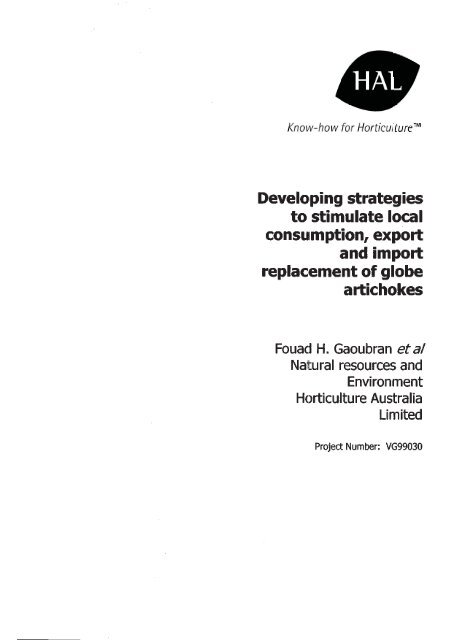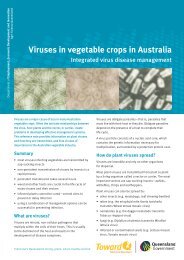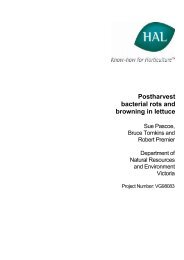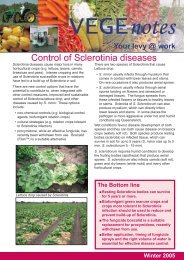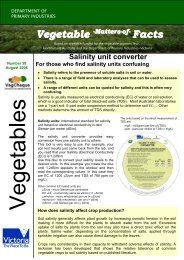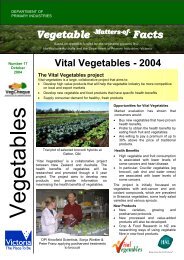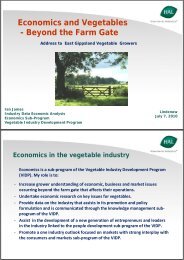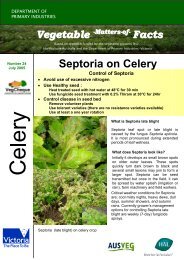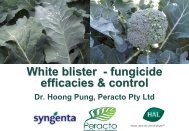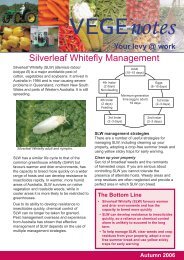Developing strategies to stimulate local consumption, export and ...
Developing strategies to stimulate local consumption, export and ...
Developing strategies to stimulate local consumption, export and ...
You also want an ePaper? Increase the reach of your titles
YUMPU automatically turns print PDFs into web optimized ePapers that Google loves.
<strong>Developing</strong> <strong>strategies</strong><strong>to</strong> <strong>stimulate</strong> <strong>local</strong><strong>consumption</strong>, <strong>export</strong><strong>and</strong> importreplacement of globeartichokesFouad H. Gaoubran eta/Natural resources <strong>and</strong>EnvironmentHorticulture AustraliaLimitedProject Number: VG99030
TABLE OF CONTENTS1 Media summary 42 Technical summary 53 Literature Review 73.1. Introduction 73.2. Botany <strong>and</strong> agronomy of globe artichoke 73.3. World production 83.4. The Artichoke industry in Australia 93.5. Uses <strong>and</strong> health benefits 103.6. Food trends <strong>and</strong> <strong>consumption</strong> 113.7. Anti-browning compounds 114 Research methodology 144.1 General status of the globe artichoke industry in Australia 144.1.1 Growers 144.1.2 Processors <strong>and</strong> food service opera<strong>to</strong>rs 154.1.3 Consumers 154.2 Evaluation of processing techniques 174.2.1 Controlling enzymatic browning 174.2.1.1 Selection of potential anti-browning treatments 174.2.1.2 Screening pro<strong>to</strong>col 174.3 Consumer acceptance of a processed product 194.3.1 Processing of product 194.3.2 Testing acceptance of processed product 195 Result <strong>and</strong> Discussion 215.1 General status of the globe artichoke industry in Australia 215.1.1 Statistics <strong>and</strong> production 215.1.2 Future vision 225.2 Status of the artichoke processing industry 225.2.1 Size of the industry <strong>and</strong> processing practices 235.2.2 Food service opera<strong>to</strong>rs 245.3 The consumer 245.3.1 Views <strong>and</strong> opinions 245.3.2 Survey results 255.4 Future of processing 285.4.1 Potential anti-browning treatments 285.4.2 Consumers' acceptance of convenience product 326 Economic considerations <strong>and</strong> benefits 366.1 Producing for the <strong>local</strong> fresh markets 366.2 Producing for the overseas fresh market 366.3 Producing for the processing market 376.3.1 The <strong>local</strong> market 376.3.1.1 The processing industry 376.3.1.2 The hospitality industry 386.3.2 Export markets 387 Recommendations 408 Technology Transfer 419 Acknowledgments 4210 References 4411 Appendices 493
1. Media SummaryStatistics indicate that the Australian production <strong>and</strong> <strong>consumption</strong> of globe artichokes havenot kept pace with the increase that has taken place with other vegetable crops. This staticstate of affairs could be attributed <strong>to</strong> a number of reasons. These include unfamiliarity of themajority of consumers with this vegetable, its use <strong>and</strong>/or difficulty in its preparation,competition from processed products <strong>and</strong> lack of promotion. This is despite the crop'sculinary versatility, excellent nutritional value <strong>and</strong> potential <strong>export</strong> prospects.Presently, the globe artichoke industry is small. However, it has the potential <strong>to</strong> exp<strong>and</strong>considerably over the next few years. Australia is currently a net importer of artichokeproducts <strong>to</strong> meet the needs of consumers <strong>and</strong> a small <strong>local</strong> processing industry that relies onimported canned artichokes as primary material for its anti-pas<strong>to</strong> <strong>and</strong> related products. Theseproducts are marketed <strong>local</strong>ly <strong>and</strong>/or <strong>export</strong>ed at a much higher price than the importedprimary material.The aim of this project was <strong>to</strong>:• Identify barriers obstructing the <strong>local</strong> expansion <strong>and</strong> <strong>export</strong> market opportunities for globeartichokes• Develop a pro<strong>to</strong>col for a frozen artichoke product• Assess the consumers acceptance of such a product• Document <strong>to</strong> growers the benefits of a processed product as a viable <strong>and</strong> complementaryalternative <strong>to</strong> their present focus on a limited fresh market.This project has shown that value adding (eg. freezing artichoke hearts) is.technically feasiblefor globe artichoke <strong>and</strong> that its commercial acceptance would considerably boost the <strong>local</strong><strong>consumption</strong> in both the retail markets <strong>and</strong> food service sec<strong>to</strong>r. The project has alsodemonstrated that a cooked <strong>and</strong> frozen artichoke product that is ready <strong>to</strong> heat <strong>and</strong> eat wouldalso be highly acceptable <strong>to</strong> the markets <strong>local</strong>ly <strong>and</strong> overseas. Given the health benefits <strong>and</strong>nutritional value of artichokes, the <strong>export</strong> opportunities will be also enhanced in the healthconscious <strong>and</strong> exp<strong>and</strong>ing Asian markets.Further work is required <strong>to</strong> bring this concept <strong>to</strong> realisation <strong>and</strong> adoption by the processingindustry. Moreover, in order <strong>to</strong> achieve this aim the artichoke industry will need <strong>to</strong> re-assessits existing <strong>local</strong> fresh market orientation <strong>and</strong> re-adjust itself <strong>to</strong> meet the expectedrequirements of a <strong>local</strong> processing industry.
2. Technical SummaryThe volume <strong>and</strong> variety of vegetables offered <strong>to</strong> Australian consumers have increaseddramatically over the last 20 years. However, the production of globe artichoke has remained<strong>to</strong> a large extent, almost static at between 500 <strong>and</strong> 1500 <strong>to</strong>nnes for decades. This situationreflects limited <strong>consumption</strong>, which can be attributed <strong>to</strong> unfamiliarity <strong>and</strong>/or difficulty in thepreparation <strong>and</strong> use of artichokes. This is despite the crop's culinary versatility, excellentnutritional value <strong>and</strong> potential <strong>export</strong> prospects. As well as pursuing opportunities <strong>to</strong>increase <strong>local</strong> <strong>consumption</strong>, there is also a need <strong>to</strong> address <strong>export</strong> <strong>and</strong> import replacemen<strong>to</strong>pportunities.Australia is currently a net importer of processed artichoke products <strong>to</strong> meet consumers'needs <strong>and</strong> <strong>to</strong> support a small processing industry that relies on canned artichokes for theproduction of anti-pas<strong>to</strong> products. Such products are marketed <strong>local</strong>ly <strong>and</strong>/or <strong>export</strong>ed at amuch higher price than the imported primary material. Furthermore, there is a certain lack ofvision in addressing the <strong>export</strong> opportunities <strong>and</strong> economic consequences of adopting newvalue adding <strong>and</strong> marketing <strong>strategies</strong> that are at the moment untapped by growers <strong>and</strong>processing firms.The aim of this project was <strong>to</strong>:a) Describe the current state of the globe artichoke industry <strong>and</strong> identify the barriersobstructing the increase in <strong>local</strong> <strong>consumption</strong> <strong>and</strong> <strong>export</strong> opportunities,b) Develop a pro<strong>to</strong>col for a frozen artichoke <strong>and</strong> other value-added products,c) Assess consumer's knowledge of fresh artichoke <strong>and</strong> acceptance of value-addedproducts <strong>and</strong>d) Document <strong>to</strong> the industry the achievable benefits of processing as a viable <strong>and</strong>complementary alternative <strong>to</strong> its present focus on the fresh market.The nature of this investigation dictated the use of four different research methodologies thatfocussed on: a) Collecting quantitative information <strong>and</strong> statistics by interviewing growers <strong>and</strong>food service opera<strong>to</strong>rs <strong>to</strong> ascertain their views on their respective industries <strong>and</strong> future vision;b) Experimenting with various anti-browning <strong>and</strong> processing treatments <strong>to</strong> test their efficacyin controlling enzymatic browning of fresh artichoke hearts destined for processing byfreezing; c) Determining consumers' acceptance of a processed products through panels ofassessors asked <strong>to</strong> indicate their level of preference for some sensory characteristics of theprocessed product <strong>and</strong> d) Documenting the economic benefits <strong>to</strong> the artichoke industry <strong>and</strong>reviewing its capacity <strong>to</strong> accommodate a <strong>local</strong> processing industry as a viable <strong>and</strong>complementary alternative <strong>to</strong> its present focus on the small <strong>and</strong> static fresh market.Our investigation showed that the artichoke industry in Australia is small by world st<strong>and</strong>ards<strong>and</strong> consists mainly of traditional family farm units clustered in Vic<strong>to</strong>ria where 90% of theannual crop (1300 <strong>to</strong>nnes) is produced. Production varies from year <strong>to</strong> year depending on thenumber of growers entering or exiting the industry. The bulk of the production is destined forthe <strong>local</strong> fresh market with sporadic <strong>export</strong>s <strong>to</strong> hospitality trades in the Asia/Pacific region.An estimated 700 <strong>to</strong>nnes of processed artichoke products are imported annually <strong>to</strong> satisfymainly the need of a <strong>local</strong> processing industry. The reliance on imported material is due <strong>to</strong> ashortage of <strong>local</strong> supply <strong>and</strong> the cheaper prices of overseas products. However, <strong>local</strong>processors have expressed interest in buying <strong>local</strong>ly, provided they can be guaranteed acontinuation of supply at prices comparable <strong>to</strong> the imported material.
3. Literature Review3.1 IntroductionWhile the volume <strong>and</strong> variety of vegetables offered <strong>to</strong> Australian consumers have increaseddramatically over the last 20 years, the interest in some such as the globe artichoke hasremained almost static. This is in spite its versatility as a vegetable <strong>and</strong> its well documentedexcellent health benefits. In Australia, the interest in globe artichoke (particularly in its freshform) remains largely restricted <strong>to</strong> particular ethnic groups who are familiar with its use. Thiscould be attributed <strong>to</strong> a number of reasons such as unfamiliarity of the majority of consumerswith this vegetable, difficulty in its preparation, competition from processed forms of tiheproduct <strong>and</strong> lack of promotion of artichokes on domestic markets.This project aimed at: a) Describing the current status of the Australian globe artichokeindustry <strong>and</strong> identifying the major barriers <strong>to</strong> its expansion b) Identifying <strong>local</strong> <strong>and</strong> <strong>export</strong>market opportunities c) Testing the technical feasibility <strong>and</strong> development of value addedartichoke products d) Assessing the consumer's acceptability of such products. The projectaimed also at documenting <strong>to</strong> the industry the achievable benefits of processing <strong>and</strong> valueadding as a viable <strong>and</strong> complementary alternative <strong>to</strong> its present focus on the limited <strong>and</strong>unpredictable fresh market. The project also <strong>to</strong>uched on the import replacement issue <strong>and</strong>reviewed the capacity of the artichoke producers in meeting the requirements of a <strong>local</strong>processing industry. Furthermore, as part of this project, an overseas visit was undertaken bythe principal investiga<strong>to</strong>r <strong>to</strong> attend the 4 th International Congress on Globe Artichoke in Italy<strong>and</strong> <strong>to</strong> review the progress in artichoke processing in two leading countries in this field (seesummary report in Appendix 8).The final outcome of the information gathered will be a re-positioning of the globe artichokeindustry <strong>to</strong> increase production in the face of an anticipated increase in <strong>local</strong> <strong>consumption</strong> <strong>and</strong><strong>export</strong> opportunities.The approach taken in this project for solving the problems associated with a crop such asglobe artichoke could be applicable <strong>to</strong> other marginal vegetable crops. Therefore, it is hopedthat this report would be a stepping s<strong>to</strong>ne for the initiation of further research projects thataddress value adding <strong>and</strong> marketing in other vegetable crops with similar predicaments <strong>to</strong>globe artichoke.3.2 Botany <strong>and</strong> agronomy of globe artichokeThe globe artichoke {Cynara scolymus) belongs <strong>to</strong> the compositae family <strong>and</strong> is one of thefew vegetable crops that can be grown as an annual or as a perennial. It is native <strong>to</strong> theMediterranean region, possibly the Middle East, hence the Arabic origin of the name(ardichoki) meaning "earth thorn" (Simpson <strong>and</strong> Ogorzaly, 1995). The genus Cynaracomprises seven wild species also native of the Mediterranean basin with the wild cardoon{Cynara cardunculus) considered the closest relative <strong>and</strong> the primary wild gene-pool <strong>to</strong> thecultivated globe artichoke (Rottenberg <strong>and</strong> Zohary, 2000). The globe artichoke should not beconfused with the Jerusalem artichoke (Helianthus tuberosus L.) a plant native <strong>to</strong> theAmericas <strong>and</strong> related <strong>to</strong> the sunflower (Schultheis, 1999) or the Chinese artichoke (Stachyssieboldii Miq.), both of which are grown for their edible tubers. From its origin as a wildplant, the globe artichoke has developed <strong>to</strong> become a luxury vegetable as we know it now,cultivated for its edible immature floral bud (head) which is available from late autumn <strong>to</strong>early spring (Plate 1).
Artichoke is a cross pollinated plant that can be propagated vegetatively as a perennial crop(using stumps <strong>and</strong> offshoots) or as an annual crop (using seeds). However, in some overseascountries (eg. Italy, France <strong>and</strong> Egypt) tissue culture is fast becoming an acceptablealternative <strong>to</strong> the traditional propagation techniques especially for the production of virus freematerial. Regardless of the propagation technique used, it takes between 5 <strong>to</strong> 7 months for aplant <strong>to</strong> produce heads ready for the first cut. Some overseas countries rely on foliarapplications of growth hormone sprays (eg. gibberellic acids) <strong>to</strong> increase earliness <strong>and</strong> theuniformity of bud development. The plant grows well in a range of soil conditions providingthey are fertile <strong>and</strong> well drained <strong>and</strong> prefers coastal areas with a mild frost-free climate withtemperatures between 15 <strong>to</strong> 20°C during bud formation in spring. Spacing between rows <strong>and</strong>plants will determine the size of the heads on the plant <strong>and</strong> the final number of plants in afield. Ryder et al. (1983) reviewed estimates for plant spacings which optimise <strong>to</strong>talyield/unit area for a number of artichoke producing countries. These estimates variedbetween countries <strong>and</strong> ranged from 0.18m 2 /plant in Egypt <strong>to</strong> 0.9m 2 /plant in USA (California).However, the authors maintained that increasing density generally decreased the yield/plant.Normally density would range between 3000 <strong>to</strong> 6000 plants/ha.There are a number of world wide artichoke cultivars with considerable morphologicalvariation such as size, bud shape, colour <strong>and</strong> spininess of the bracts. Many cultivars aresynonym, with some in Italy having up <strong>to</strong> fifteen different names given after the areas wherethey are grown (Prof. V. Bianco, personal communication). Major research centres forbreeding <strong>and</strong> cultivar selection exist in Italy, Spain <strong>and</strong> France. A comprehensive collectionof over 130 cultivars collected world wide is kept at the Gennplasm Institute, Bari Universityin Italy. Di Venere et al. (2000) found remarkable differences in the biochemical constituentsof 35 artichoke cultivars. According <strong>to</strong> the researchers such useful information could helpdetermining the suitability of various cultivars <strong>to</strong> specific uses such as fresh, frozen, brined orpreserved in oil.3.3 World productionIn 1999 the world's production of artichoke was about 1.2 million <strong>to</strong>nnes from an area of119,000 hectares (Anon. 1999a). Nearly 85% of the world's artichokes are grown incountries bordering the Mediterranean basin (Bianco, 2000). Italy <strong>and</strong> Spain dominate theworld production with other countries showing great interest in the crop. In the Northernhemisphere, Egypt is exp<strong>and</strong>ing its production ranking fifth in the world <strong>and</strong> becoming anaggressive <strong>export</strong>er <strong>to</strong> markets in Europe <strong>and</strong> Northern America. The USA has also beenexp<strong>and</strong>ing its production steadily with most of it located in the central <strong>and</strong> southern coastalareas of California. Argentina <strong>and</strong> Chile are two Southern hemisphere countries showinginterest in exp<strong>and</strong>ing their artichoke production. Table 1 lists the world <strong>to</strong>p producingcountries in 1999 <strong>and</strong> periods when the crop is available on their <strong>local</strong> markets. However, thedates listed are only a guide <strong>and</strong>jcould differ by a few weeks within the same countrydepending on the region where artichoke is grown <strong>and</strong>/or prevailing weather conditionsduring the growing season.
Table 1. Major World Producers of Globe Artichoke.Country Area harvested (ha) Production (t) Availability of Crop*Italy 51,000 472,000 Oc<strong>to</strong>ber <strong>to</strong> MarchSpain 18,000 254,000 September <strong>to</strong> AprilFrance 13,000 73,000 April <strong>to</strong> NovemberArgentina 5,000 85,000 June <strong>to</strong> Oc<strong>to</strong>berEgypt 3,000 57,000 Oc<strong>to</strong>ber <strong>to</strong> AprilUSA 5,000 51,000 Oc<strong>to</strong>ber <strong>to</strong> MarchAlgeria 4,000 30,000 September <strong>to</strong> MarchMorocco 2,000 28,000 September <strong>to</strong> AprilTurkey 2,000 27,000 November <strong>to</strong> JuneChile 3,000 24,000 June <strong>to</strong> Oc<strong>to</strong>berGreece 2,000 23,000 Oc<strong>to</strong>ber <strong>to</strong> MayTunisia 3,000 25,000 September <strong>to</strong> AprilPeru Not available 4,000 June <strong>to</strong> Oc<strong>to</strong>ber\ustnilu' 300 1 500 M.i\ <strong>to</strong> ScpLunbLrSource: FAO Production Yearbook Vol. 53, 1999* Dates compiled by the authors** Figures provided have been estimatedMajor world producers put great emphasis on maintaining a good s<strong>to</strong>ck of cultivars <strong>and</strong>continuously breeding <strong>and</strong> selecting hybrids for particular characteristics such as earliness ofproduction, head size, yield <strong>and</strong> colour. The following are the major cultivars grown in someof the leading producing countries including Argentina, a country considered a competi<strong>to</strong>r <strong>to</strong>Australia given the similarity of seasons.Italy: Romanesco, Violet<strong>to</strong> di Sicilia, Violet<strong>to</strong> di Provenza (known for its earliness <strong>and</strong> highyield) Orl<strong>and</strong>o, Spinoso violet<strong>to</strong> di Palermo, Spinoso Sardo. Some recently selected cultivarsare; Apollo^ Etruso, Moro di Corne<strong>to</strong>, Branco Star, Pacific, Latino.Spain: Blanca de Tudela (early producer, represent 90% of the production), Moret<strong>to</strong>, Camusde Bretagne.France: Camus de Bretagne, Castel, Violet de Provence, Calico, Salambo, Popvert.Argentina: Na<strong>to</strong>, Blanc Hyerois, Salanquet, Frances (represent 90% of artichoke areas), OroVerde, Blanco de San Juan, Esmeralda, Camus de Bretagne, Violet of Provenza, Italiano.USA: Imperial Star, Green Globe, Emerald, Gr<strong>and</strong> Beurre, Tolpiot, Purple Sicilian.Egypt: Baladi, Fransawee, Imperial Star, Large Green, Green Globe, Violet, Gr<strong>and</strong> Beurre.3.4 The artichoke industry in Australia """Claims are made that artichokes were introduced <strong>to</strong> Australia by the first fleet in the first year(1788) of European settlement in Australia <strong>and</strong> that seeds were planted on Norfolk Isl<strong>and</strong>(Anon., 2000a).Italian growers in Vic<strong>to</strong>ria around the late 1940's <strong>and</strong> early 1950's first grew the globeartichoke commercially in Australia. The bulk of the artichoke crop in Australia has beengrown close <strong>to</strong> the shores of Port Phillip Bay at Werribee South in Vic<strong>to</strong>ria (Sutherl<strong>and</strong>,1995). This is because the crop favours coastal climatic conditions. However, varieties arebeing developed in California for broad climatic adaptability (Anon., 1998a).9
Dr.S.C.Tan <strong>and</strong> Mr H.Hoffmann in Western Australia are also looking in<strong>to</strong> suitable U.S.cultivars for that state (Horticulture Australia Limited, project No.VG97042). In Italyresearchers have found remarkable differences in the biochemical constituents betweendifferent cultivars (Venere et al., 2000). According <strong>to</strong> this research this variability could be auseful indica<strong>to</strong>r of the suitability of various cultivars <strong>to</strong> specific uses (eg. fresh, frozen,preserved in oil etc.). Unlike in overseas countries where a broad gene pool of cultivarsexists, in Australia there is a serious shortage of reliable cultivar material. Some of thepopular cultivars currently used by many growers, such as Green Globe <strong>and</strong> Purple Globe areof unknown origin. The majority of growers appreciate the practicality of using seededcultivars that are currently available. However, few are currently experimenting with suchcultivars <strong>to</strong> test their general performance <strong>and</strong> reliability.Various recent publications refer <strong>to</strong> Australian artichoke production as being steady at 500<strong>to</strong>nnes. However, based on the information gathered in our investigation, the artichokeproduction figure is more like 1300 <strong>to</strong>nnes (see section 5.1.2). Despite this small productioncompared <strong>to</strong> some overseas producers (Table 1), Australia manages <strong>to</strong> <strong>export</strong> small volumesof fresh artichokes in an ad-hoc fashion mainly <strong>to</strong> hospitality trades in the Asia/Pacific region.Trade figures, show that between 1994/95 <strong>and</strong> 1999/2000, the volume of globe artichokes(fresh or chilled) <strong>export</strong>s ranged from a low of 2.5 <strong>to</strong>nnes ($A5580 per <strong>to</strong>nne f.o.b.) in1995/96 <strong>to</strong> a high of 80 <strong>to</strong>nnes ($A3342 per <strong>to</strong>nne f.o.b.) in 1999/2000 (Anon., 2001a).Statistical Information Service). The statistics also show that Australia's four major <strong>export</strong>smarkets in 1999 were Taiwan, New Caledonia, Singapore <strong>and</strong> Brunei. Other markets include;Japan, Singapore, China {Hong Kong), Korea, Malaysia <strong>and</strong> Germany.3.5 Uses <strong>and</strong> health benefitsVarious parts of the globe artichoke can be used in different ways <strong>and</strong> for different purposes.The principal edible portion of the immature flower bud we call the artichoke's heart iscomposed of the fleshy bracts <strong>and</strong> the receptacle <strong>to</strong> which the bracts are attached. This part isconsumed in a number of ways, such as steamed, boiled, stuffed <strong>and</strong> then baked, marinated<strong>and</strong> battered <strong>and</strong> then fried etc. Another part is the artichoke stalk which when peeledexposes its core, another edible portion of the plant that has a similar texture <strong>and</strong> flavour <strong>to</strong>the heart. A favourite Italian way of eating artichoke is "in pinzimonio" which involvesdipping the fleshy parts of the bracts one by one in<strong>to</strong> a vinigraite dressing mixture as above<strong>and</strong> scrapping it off between the teeth. Besides fresh, various forms of processed artichokeare available on the markets such as preserved whole hearts in brine, frozen <strong>and</strong> antipas<strong>to</strong>(appetiser) products, purees (Plate 2).Globe artichoke is a versatile vegetable, renown for its nutritional value <strong>and</strong> excellent health^benefits because of its high fibre, vitamin <strong>and</strong> mineral content, especially iron (Appendix 1).This is in addition <strong>to</strong> its high content of phy<strong>to</strong>chemical or nutraceutical substances withmedicinal functions such as caffeoylquinic acid <strong>and</strong> cynarin. It is well documented thatextracts of globe artichoke leaves are known for their ability <strong>to</strong> de<strong>to</strong>xify the liver <strong>and</strong><strong>stimulate</strong> bile secretion (Wegener <strong>and</strong> Fintelmann, 1999) <strong>and</strong> <strong>to</strong> inhibit cholesterolbiosynthesis (Gebhardt, 1998). In Argentina, growers can generate additional income fromselling artichoke leaves (1.5-3.0 kg per plant at approximately $A1.00 per kg) <strong>to</strong> thepharmaceuticals industry (Garcia et al.2000). Cardinali et al., 2000 have shown that theleaves <strong>and</strong> external bud bracts (which are discarded as waste during processing) representabout 70% of the <strong>to</strong>tal biomass <strong>and</strong> could be utilised <strong>to</strong> extract important phy<strong>to</strong>chemicalcompounds. Almela et al., 2000 found that artichoke waste is a valuable material that couldbe used for animal fodder due <strong>to</strong> its Mgh <strong>to</strong>tal protein content, which is comparable with other10
sources of animal feed. Work on animal nutrition in Italy has shown that adding artichokebracts <strong>to</strong> lambs' feed led <strong>to</strong> the lowering of fatty acid components <strong>and</strong> cholesterol in the meatproduced (Marsico et al., 2000).3.6 Food trends <strong>and</strong> <strong>consumption</strong>Changes in consumers' lifestyles including buying <strong>and</strong> eating habits are occurring at a fastrate in many developed countries. Australia, according <strong>to</strong> the vegetable industry strategicplan, has undergone significant demographic changes that have brought a diversity of foodwhich modified consumers behaviour <strong>and</strong> lifestyle trends (Anon., 1999b). These changescould also be partially attributed <strong>to</strong> the global economic transformation <strong>and</strong> the informationrevolution that is taking place at a fast rate. With the health message becoming widely spread<strong>and</strong> more noticeable, consumers are turning more <strong>to</strong> fruit <strong>and</strong> vegetables <strong>and</strong> away from meat<strong>and</strong> dairy products. In the USA, red meat <strong>consumption</strong> declined 17% over a period of 30years from 79% in 1970 <strong>to</strong> 62% in 2000 (Anon., 2001b).Between 1955 <strong>and</strong> 1995, the Australian per capita <strong>consumption</strong> of <strong>to</strong>tal fresh vegetable hasincreased by 39% (from 117 <strong>to</strong> 163 Kg) (Anon., 1998b). 1997/98 Horticultural StatisticsH<strong>and</strong>book. Australian Horticultural Corporation, Sydney]. Reports from the USA put theyearly per capita <strong>consumption</strong> of artichoke at 272g (Anon.,1999c), about ten times that ofAustralia (28g) (Hoffmann, 2000), whereas in a country like Italy per capita <strong>consumption</strong> ofartichoke is 7kg (Bianco,2000).Analysing food trends around the world, Daly et. al. (1997) found that leading vegetableproducing countries are increasingly relying on value adding of products. The study alsofound changes in consumer behaviour which is having an impact on the vegetable sec<strong>to</strong>r suchas an increasing trend <strong>to</strong>wards convenience foods (eg. supermarkets offering "meals <strong>to</strong> go""heat <strong>and</strong> eat" etc.). While at the moment Australian consumers lack awareness of suchmeals, there could be a big opportunity for hotels <strong>and</strong> restaurants (George, 2000). Marketresearch claims that Australian shoppers will be able <strong>to</strong> order over the fax or phoneconvenience meals from a new breed of supermarkets (Anon., 1998c). Recent reportsindicate that Australians already spend more than $920 million a year shopping on-line forconvenience, a figure that's set <strong>to</strong> skyrocket in the future (Sloane, 2000). A similar study byHughson (1997) shows scope for the introduction of new frozen value-added vegetablesproducts. Between 1984 <strong>and</strong> 1990 sales of frozen meals in Australia grew from $10 million <strong>to</strong>$80 million (Anon., 1995). Australians consume about 500 grams of frozen meals per capitaper annum well behind the UK (1000 grams) <strong>and</strong> the USA (2000 grams). The frozen mealsmarket in Australia has a retail value of $100 million (Quin<strong>to</strong>n Wilkinson, personalcommunication).Changes in food <strong>consumption</strong> patterns duet<strong>to</strong> changes in lifestyle are also taking place inoverseas countries. For example in Japan (aTmajor market for Australian food <strong>export</strong>s) wheredem<strong>and</strong> for fast <strong>and</strong> convenience foods is increasing. The quantity of frozen vegetablesimported over a,period of eight years from 1988 <strong>and</strong> 1996 increased by 90% (from 333,709<strong>to</strong>nnes <strong>to</strong> 633,008 <strong>to</strong>nnes) (Nguyen, 1998). The import of processed artichokes <strong>to</strong> the USAincreased by 89% from 19,157 <strong>to</strong>nnes <strong>to</strong> 36,284 <strong>to</strong>nnes (Hofmann,1999-personalcommunication).3.7 Anti-browning compoundsThe fruit <strong>and</strong> vegetable processing industry is undergoing constant development in response<strong>to</strong> the ever increasing dem<strong>and</strong> for high quality convenience products. Processing involvesvarious operations such as cutting, ttimming <strong>and</strong> peeling, all of which induce discolouration11
<strong>and</strong> browning of the tissue (due <strong>to</strong> various enzymatic <strong>and</strong> non-enzymatic reactions) which is amajor problem that occurs especially during the freezing process. While the enzymepolyphenol oxidase is considered the major one responsible for tissue browning in artichoke,there are indications that other enzyme systems such as peroxidase could also be contributing<strong>to</strong> the <strong>to</strong>tal discolouration in some fruits <strong>and</strong> vegetables (Vamos-Vigyaso, 1981). It isgenerally accepted that during artichoke processing the cell damage that occurs leads <strong>to</strong> darkcolouration of the tissue which is due <strong>to</strong> the reaction of phenolic compounds such ascaffeolyquinic acid with ferric iron (Hughes et al., 1962; Mathew <strong>and</strong> Parpia, 1971).One of the main purposes of this study was <strong>to</strong> experiment with various anti-browningcompounds <strong>to</strong> find the most effective in controlling browning of artichoke during the freezingprocess. It is known that anti-browning compounds can be used singularly or in combinationfor their synergistic effect (Son et al., 2001). A large number of approved food additives haveshown various degrees of inhibi<strong>to</strong>ry effects such as citric <strong>and</strong> ascorbic acids on carrambola(Weller et al., 1997), L-cysteine <strong>and</strong> citric acid in pota<strong>to</strong>es (Gunes et al., 1997), acetic acid inLettuce (Tomas-Barberan et al., 1997) <strong>and</strong> citric acid <strong>and</strong> ascorbic acid in artichoke (Lattanzioet al., 1989). Another technique used <strong>to</strong> inhibit enzymatic browning is blanching in plainwater heated <strong>to</strong> various temperatures or water mixed with organic chemicals <strong>to</strong> enhance theblanching effects. Toivonen (1992), working on enzymatic browning in various parsnipscultivars, concluded that the effectiveness of anti-browning agents is limited by the extent ofthe injury sustained by the particular cultivar.
7. RecommendationsThe <strong>local</strong> globe artichoke industry possesses the necessary expertise <strong>and</strong> reasonably modernmodes of production <strong>to</strong> enable substantial expansion of the industry. Through its evaluation ofthe <strong>local</strong> production scene, this investigation has been able <strong>to</strong> identify several existingproblems <strong>and</strong> propose promising short <strong>and</strong> long term solutions that are available <strong>to</strong> theindustry. Such solutions, if properly adopted by the industry, would increase the profile of itsproduct <strong>local</strong>ly <strong>and</strong> capture a share of overseas markets. The following are some of ourrecommendations in this regard.In the short <strong>to</strong> medium term globe artichoke producers will need <strong>to</strong> re-vitalise the <strong>local</strong> freshmarket which will remain relatively small but has the potential <strong>to</strong> exp<strong>and</strong>. This will require:a) The introduction of appealing <strong>and</strong> consistent quality cultivars <strong>to</strong> ensure consumersatisfaction <strong>and</strong> repeat purchase.b) The involvement in <strong>and</strong> adoption of promotional activities <strong>to</strong> build up the industry'sprofile <strong>and</strong> that of the fresh crop. This will include developing a good workingrelationship with supermarkets <strong>to</strong> train staff on how <strong>to</strong> h<strong>and</strong>le the produce, <strong>to</strong> developattractive point of sale material such as recipes.At the present time there is a certain lack of vision in the artichoke industry with respect <strong>to</strong>investigating <strong>and</strong> adopting new processing techniques for fresh product <strong>and</strong> remains untappedby <strong>local</strong> growers <strong>and</strong> processing firms. This study recommends that for the long term growthof the artichoke industry, the fresh market will have <strong>to</strong> be supplemented by a viableprocessing sec<strong>to</strong>r that could rely for its supply on a strong <strong>and</strong> reliable <strong>local</strong> production.Processing could start by targeting <strong>local</strong> <strong>and</strong> exploring overseas niche markets. As thedem<strong>and</strong> for fresh <strong>and</strong> processed products increases growers will be able <strong>to</strong> make informeddecisions as <strong>to</strong> wether <strong>to</strong> produce for processing, fresh or both markets.Given the small <strong>and</strong> fragmented nature of the globe artichoke industry in Australia, individualgrowers do not have the necessary production capacity or marketing solidarity <strong>to</strong> develop aviable industry. Therefore, industry members interested in processing will need <strong>to</strong> coordinatetheir efforts in terms of production <strong>and</strong> marketing <strong>and</strong> if necessary take a cooperativeapproach.Furthermore, the industry needs <strong>to</strong> be attuned with the current overseas views <strong>and</strong> futuretrends of their industry at an international level. Such views were expressed at the recentlyheld Fourth International Artichoke Congress (Italy) <strong>and</strong> include:• More research needed <strong>to</strong> improve propagating material.• Selection of seed propagated cultivars that mature during autumn.• Characterise cultivars according <strong>to</strong> suitability for <strong>consumption</strong> <strong>and</strong> end use such as fresh —or processing.• Better underst<strong>and</strong>ing of the role of growth regula<strong>to</strong>rs in production.• More work in postharvest physiology <strong>to</strong> increase s<strong>to</strong>rage life.• Better underst<strong>and</strong>ing of enzymatic activities <strong>and</strong> utilisation of by-products <strong>and</strong> identify thepotential for phy<strong>to</strong>pharmaceuticals.• More research in food technology <strong>to</strong> develop ready <strong>to</strong> use <strong>and</strong> minimally processedproducts.40
8. Technology TransferThe Australian globe artichoke industry, ancillary industries (Food service etc.) <strong>and</strong>Horticulture Australia Limited (HAL) were kept abreast of the developments <strong>and</strong> progressmade during the course of this investigation in the form of written progress reports <strong>and</strong>meetings. Furthermore, the vegetable industry development officers in all states growingartichoke were briefed about the project since its initiation <strong>and</strong> kept informed about itsdevelopment. However, due <strong>to</strong> the commercial sensitivity of the results, especially thoseassociated with the processing aspect of the investigation, little detail has been published <strong>and</strong>public disclosure will be kept <strong>to</strong> a minimum until the final report is cleared by HAL.During the course of the investigation the following extension activities have been conducted:Industry contacts <strong>and</strong> briefings.Australian Restaurant ajid Catering Association contacted.Twenty food processors briefed <strong>and</strong> invited <strong>to</strong> express views on project.State vegetable EDO's contacted <strong>and</strong> summary of project brief forwarded for publication.Further contacts were maintained <strong>to</strong> keep EDO's abreast with prdgress made.Contacted wholesale market officials (eg. Sue Dodd, Sydney market; Noel Harvey, Qld. Fruit<strong>and</strong> Vegetable Manager; Lisa-Huong Nguyen, SA-Virginia Hort. Centre).Communication established with members of the food <strong>and</strong> hospitality service(Chefs/Restaurant manager's etc.).Publications.Newsletter produced <strong>and</strong> distributed quarterly <strong>to</strong> 40 growers <strong>and</strong> processors.State wide media releases sent <strong>and</strong> published in written media such as Sheppar<strong>to</strong>n News,Country News <strong>and</strong> Southern Farmer.Article published in VegeLink newsletter.Article published in Proceedings of Fourth International Artichoke Congress (Bari-Italy).Article printed in "Good Fruit <strong>and</strong> Vegetables".Two articles printed (artichoke recipes <strong>and</strong> summary of consumer research) in WA Vegelink(insert in WA Grower) in December 2000.Article prepared for media release "Frozen artichokes - a cool alternative" <strong>to</strong> promote aprocessed artichoke <strong>and</strong> <strong>to</strong> entice potential inves<strong>to</strong>rs <strong>to</strong> express their interest incommercialising the technique.Submission of abstract for a poster presentation on processed artichokes at the forthcomingAustralian Postharvest Conference (23-28 September, 2001) in Adelaide.Article on the convenience of a processed artichoke product printed in the new VegChequenewsletter (VegetableMatters).Growers meetings.Meeting <strong>and</strong> briefing Agmark's chairman, growers, distribu<strong>to</strong>r <strong>and</strong> marketing agent.Two meetings with Werribee's young vegetable growers.Field Days <strong>and</strong> Promotional activities.Presentation <strong>and</strong> circulation of h<strong>and</strong>out at monthly meeting of Werribee Grower Group.Promotion of artichoke project in a display at the IHD open days (Oct. 6-7) for both industry<strong>and</strong> the public.Poster presentation at the Horticulture in NRE conference at the Institute for HorticultureDevelopment (Sept. 6-7).41
Poster presentation at the Gympie (Qld.) VGA fieldday (Nov. 15).Artichoke poster displayed at the Werribee Expo on 3 <strong>and</strong> 4 May, 2001.Promotional posters were also displayed at The Horticulture Conference held at theDepartment of Natural Resource <strong>and</strong> Environment (Knoxfield).International Exhibitions <strong>and</strong> Conferences.Poster presentation at the IV International Artichoke Congress (Bari- Italy).Translation of poster from English <strong>to</strong> Japanese on 2 st<strong>and</strong>s <strong>to</strong> promote Australian artichokes atthe 10 th International Food Fair (Oct. 5-9) held at Kitakyushu (Japan). A <strong>local</strong> TV crew filmedthe poster:Liasing with artichoke growers, agribusiness section <strong>and</strong> Australian <strong>export</strong> company <strong>to</strong> set upa live exhibit of Australian artichoke at the above event.Export of a sample of frozen artichoke hearts <strong>to</strong> Japan for comments by the Head Chef of alarge Italian restaurant chain <strong>and</strong> <strong>to</strong> explore the acceptability of the product in that market.
9. Acknowledgments:During the course of this study we have received valuable support <strong>and</strong> advice from manypeople either directly related <strong>to</strong> the artichoke industry or other related fields such as, the foodservice industry, processors, importers <strong>and</strong> <strong>export</strong>ers, all of whom contributed generously intime <strong>and</strong> advice <strong>and</strong> helped us focus our work. The assistance <strong>and</strong> complete co-operation <strong>and</strong>enthusiasm of all growers of globe artichoke who were interviewed in the Werribee <strong>and</strong>Keilor districts, particularly Tony <strong>and</strong> Joe Farr<strong>and</strong>a, Robert Nave <strong>and</strong> Anthony Senserrick.Thanks also <strong>to</strong> Alfred Lazer, Jeff Santa-Lucia, Darren Webb (Marketing Manager, SolutiaAustralia Pty Ltd). Thanks also <strong>to</strong> our colleagues at DNRE for their assistance: Ross Clarke,Fiona Thomson <strong>and</strong> Stephen Moore.From the Food Services Opera<strong>to</strong>rs Industry in Melbourne, Vic<strong>to</strong>ria the following are alsogratefully acknowledged:Peter McGee, Managing Direc<strong>to</strong>r, Sundown Foods, Knoxfield.Paul Fleggo, Manager, Pomodoro Brothers Pty Ltd., Airport-West.Malcolm Engl<strong>and</strong>, Manager, Sevillo Pty. Ltd., Brunswick.Arthur Karas, Manager, The Grill House Pty. Ltd., Campbellfield.Peter McBeth, Managing Direc<strong>to</strong>r, Marvel Packers Pty. Ltd., Hallam.Paul McBeth, Marvel Packers Pty.Ltd., Hallam.Quin<strong>to</strong>n Wilkinson, R&D Manager, McCain Foods (Australia) Pty Ltd, Ballarat.Daniel Grunfeld, Sales <strong>and</strong> Marketing Manager, Chefs Pantry, Braeside.Mathew Tee, Chef, Kingson Links Golf Club, Rowville.Con Gryllakis, Restaurant owner, Marketa Restaurant, Hawthorn.Geoff Haverl<strong>and</strong>, Head Chef, Marketa Restaurant, Hawthorn.During the principal investiga<strong>to</strong>rs visit <strong>to</strong> overseas research centres, many people involved inthe research <strong>and</strong>/or the food technology of globe artichoke helped in organising his time table<strong>and</strong> gave generously of their time. Special thanks <strong>to</strong>:Mr. Jean-Michel Collet (CTFJL - France).Mr. Jean Corre (INRA - France).Mr. Bernard Macre (Dir. Co. Bre<strong>to</strong>nne de L'Artichaut - France).Prof. F. Abdel Aziz (Inst, of Agr. Res., Dept. of Agr. T Egypt).The late Mr.Ibrahim El-Hessi (Dir. of Extension, Dept. of Agr.- Egypt).Mrs. R. Foda (Mktng. Mngr. United Food Ind., Montana-Egypt)Mr F El Guretly (Prod. Mngr. United Food Ind., Montana-Egypt)43


